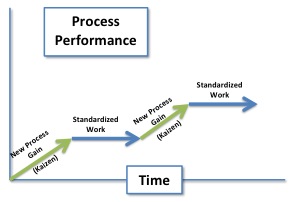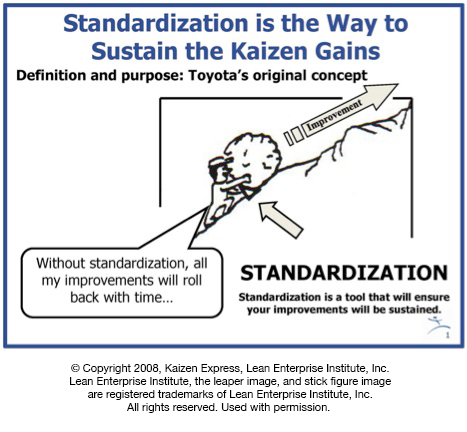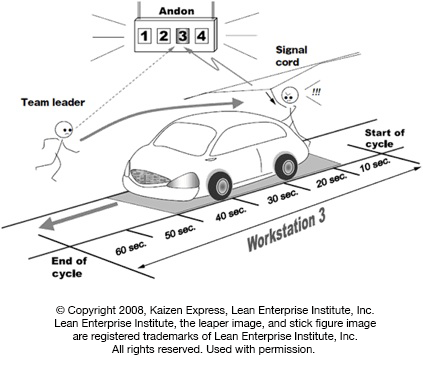As I have told my students many times, the least sexy part of lean is standardized work. But, standardized work is the linchpin of the lean system. As the godfather of lean, Taiichi Ohno, said in his oft-quoted statement, “Where there is no standard, there can be no kaizen."
I would add to his statement. Where there is no standardized work, there is no process discipline, team member accountability, reliable data, continuous improvement or lean sustainability. The graph below illustrates the critical role of standardized work in the continuous improvement journey. Standardized work captures the new process improvements the team made from its kaizen efforts. And it is the baseline for the next PDCA experiment and the next new process gain.
Standardized work captures the new process improvements the team made from its kaizen efforts. And it is the baseline for the next PDCA experiment and the next new process gain.
That's why it is critical for everyone throughout the organization to understand the dual role of standardized work and continually reinforce the importance of adhering to work standards, even when team members want to do their own thing and team leaders don't view standardized work as that important.
Standardized work is the playbook. It's what the team has decided is the best way — at this point in time — to get the job done and succeed on a daily basis. It supports all the organizational learning and training for the team members.
The team needs to follow the playbook. When the play is called for a post pattern over the middle, the quarterback expects the receiver to break inside and not decide to run a fly pattern because it's the fastest way to the end zone. Team members can't be designing and running their own plays because they want to take a shortcut or they don't like the play called. That's not teamwork. That's not lean. That's where kaizen and continuous improvement break down as the Lean Learning Institute diagram below suggests. Standardized work that works in a lean system is more than just describing its three component parts: work sequence, takt time and in-process inventory. It is more than standard work charts, production capacity charts and standardized work combination tables. Yes, these are essential tools, but standardized work is more.
Standardized work that works in a lean system is more than just describing its three component parts: work sequence, takt time and in-process inventory. It is more than standard work charts, production capacity charts and standardized work combination tables. Yes, these are essential tools, but standardized work is more.
Standardized work needs to be a highly visible, practical way of organizing and managing human behavior and, most importantly, convincing everyone involved that standardized work is critical to the continuous improvement journey.
The leaders of any organization that professes to follow work standards and have a standardized work system that works should be able to walk onto the plant floor or into the office area and answer the following three questions quickly and confidently.
- Do the team members doing the work know exactly what to do and in the proper sequence, and are they doing it right now?
- Do the team leaders supervising the team members doing the work know if they are doing the work according to the standard?
- What do the team leaders do if they see standards not being followed or get a call for assistance?
The diagram below depicts a highly visible factory floor layout that would allow leaders in this organization to confidently answer all three of these standardized work questions.
How do your work areas look? Do you know what your team members are really doing? Do you really care if they are following the work standards? If not, don't even bother to ask why lean is failing to produce the quality, cost and cycle time results you think it should. The answer is staring you right in the face.
In almost all cases where my student teams have conducted lean workouts on dysfunctional processes, one of the primary root causes they discover is lack of work standards or the work standards are not being followed.
Sure, the student teams can design a new target condition that includes standardized work with less waste and, if implemented correctly, process gains will follow. But how long will they last?
That's why there is another tougher to answer and more crucial fourth question that all leaders of lean organizations need to ask themselves:
4. Do the people doing the work and their team leaders understand how standardized work fits in the kaizen continuous improvement journey?
In other words, do they know why standardized work is important or are they just doing as they are told? If it's the latter, then process discipline, continuous improvement and the sustainable lean journey are all in question.


